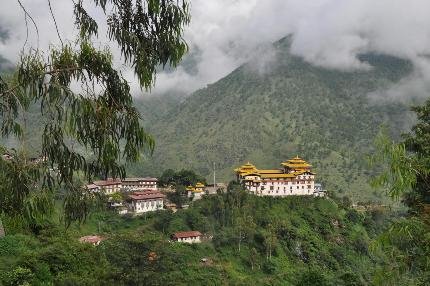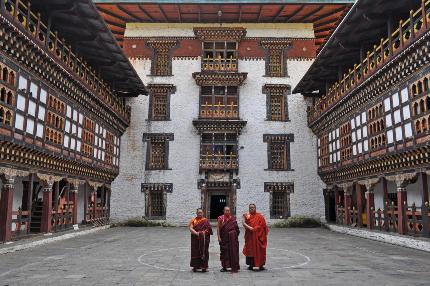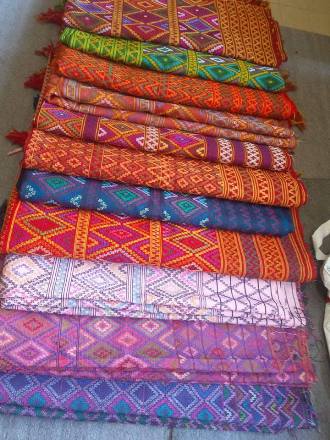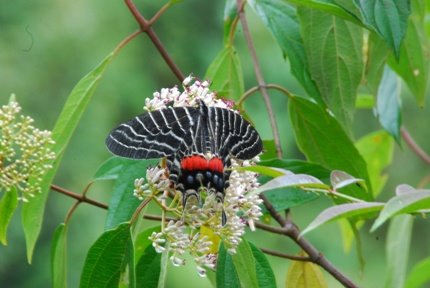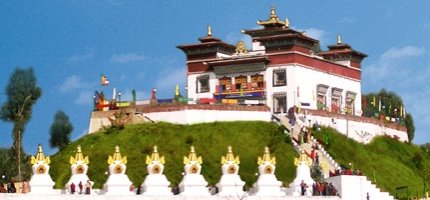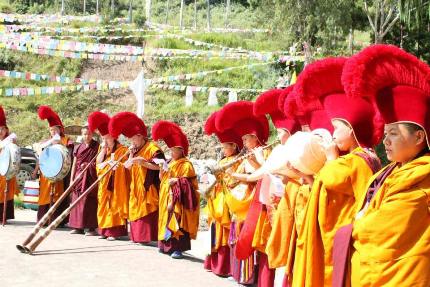Tours of Trashigang & Trashi Yangtse
Proudly referred to as the “Jewel of the East” by the Bhutanese, Trashigang is the Easternmost dzongkhag of Bhutan and its borders skirt the boundaries of Arunachal Pradesh. Trashigang is a huge district that has varying altitude from 700 to 4200 m. The biggest river of Bhutan, the mighty Dangmechu flows across this district. Trashigang town lies on the eastern side of the valley, right above the Drangme Chu River to the southern tip of where the Gamri River meets it.
This was once a huge trading center for merchants of Bhutan, Tibet and India. If you have traveled to Eastern Bhutan before then you will probably know that Trashigang is an important junction of the East West Highway and it has direct road connectivity to Samdrup Jongkhar and further on to Assam. Incidentally, the dressing style of Trashigang locals (mostly tribes Sakteng and Merak live there) is quite different from the standard Gho and Kira worn by the Bhutanese locals across the country.
There is a domestic airport in Trashigang named Yongphulla Airport and it also holds the distinction of housing one of Bhutan’s first accredited college... the Sherubtse College. Earlier flights from Paro used to come in but the service has been temporarily suspended due to political issues. However, Yonghpulla will soon be operational and then you could avail the Druk Airways flight from Paro.
Trashi Yangtse holds the distinction of being the newest Dzonkhang in Bhutan (it was established in 1992). About 1437 km of luscious alpine forests lie in Trashi Yangtse (this includes a part of the Bumdeling sanctuary). Like Trashigang, Trashi Yangtse is also culturally diverse and Bramis, Kurteops, Khengpas along with Tshanglas reside here in perfect harmony
How to reach Trashigang and Trashiyangtse
As you approach Trashigang or Trashiyangtse the first sign will be scores of prayer flags fluttering in the wind. The coloured ones bring in luck and prosperity while the white ones respect the dead. The road to Trashigang from Samdrup is not very smooth and is very windy (you will be reminded of Darjeeling’s Hill Cart Road). The scenery is breathtakingly beautiful and the view changes every 3 seconds. If you are a photography addict then the journey is going to take you a long long time.
En route to Trashigang you will cross the Sam Choling Monastery (one of Bhutan’s few nunneries). About half an hour away from the Monastery you will see a view like the picture below and know that you are about to enter Trashigang.
Sam Choling Monastery
Photo: World Monuments Fund
Bus service from Thimphu to Trashigang is good and the bus leaves from Thimphu terminal at 7 a.m. and reaches Trashigang at 5.30 p.m. the next day. There is a night halt at Bumthang.
From Thimphu, a coaster bus leaves every Thursday and Saturday to Trashi Yangtse. The bus leaves at 7.00 a.m. in the morning and reaches at 5.30 p.m. the next day after halting for the night at Bumthang.
You can also opt to take a bus from Phuntsheoling to Trashi Yangtse (the bus runs only on Wednesday though). It starts off at 5.00 a.m. and reaches at 6.00 p.m.
If you have entered Bhutan via SamdrupJonghkar border then catch a bus to Trashigang (there are two buses every day). 2 coaster buses operated by Bumpa Transport start off at 7.30 a.m. and 8.00 a.m. every day and reach at 4.00 p.m. and 4.30 p.m.
If you are travelling to eastern Bhutan then you must be approaching Trashigang either through Mongar or Lhuentse. From Mongar, you can catch a bus to Trashigang at 6.30 a.m. and reach at 11.30 a.m. The bus runs every day apart from Saturday. From Lhuentse…there are no buses to Trashigang and you will have to rely on cab.
Between Trashigang to Trashiyangtse there is regular bus service and the journey takes 3 hours.
From SamdrupJonghkar to Trashigang its 180 km and the reserved taxi will take 3060 NU (approx.). From Thimphu to Trashi Yangtse the distance is 582 km and the reserved taxi will take 9894 NU (approx.). From Thimphu to Trashigang the distance is 551 km and the cab will take 9367 NU. From Trashigang you can take a reserved cab to Trashi Yangtse for 1000 NU (includes sightseeing on the way and waiting charges).
Trashigang Dzong
The Trashigang Dzong is one of the better known Dzongs of Eastern Bhutan. Fondly called the Fortress of the Auspicious Hill, this Dzong was built in the year 1659 by Mingyur Dempa (the third desi of Bhutan) to protect the area against Tibetan Invaders.
The gigantic fortress is perched on a cliff like structure that overlooks the Dangmechu River. Legends say that such is the image of the Dzong that a Tibetan Invader once remarked that “the Dzong is not present on the ground. It’s a sky dzong”. The Trashigang Dzong has been the political hub of Eastern Bhutan since hundreds of years.
The Trashigang Tsechu is held in the 10th month of the Lunar calendar and attracts lots of tourists (check the page on
Bhutan Festivals). You will find apparently domesticated mountain goats roaming in the exterior courtyards. The administrative and monastic arms of the Dzong both face the same courtyard. The slate carvings of Send Doma (local Guardian who is believed to be a hermaphrodite) and the beautiful Mani Lhakang are points of interest inside the Dzong.
Trashigang Dzong
Photo: World Monument Fund Website
There are about 6 Lhakhang’s inside the temple and there is a gorgeous goenkang with a Yeti painting. Another important component is Choegi Gyelpo Chapel that is quite terrifying to look at. Interestingly Choegi Gyelpho is known as the lord of Death and Enforcer of law who weighs all the good and evil acts of every person at the end of his/ her life.
Trashiyangtse Town
The Trashiyangtse district lies adjacent to the Trashigang district (it will take you 2 hours to reach). the town has a pot pourri of different strains like the Bramis and Tshanglas from Tawang and the Kurteops from Lhuentse along with the Khengpas from Zhemgang. It’s interesting to walk through this tiny little town with traditional Bhutanese homes and rickety shops and watch people around speak so many different languages. There is a Dzong and an archery ground in the town which you might want to see.
However, if you are an avid shopper then visiting the Trashi-Yangtse town becomes something of a priority. Paper making and Wood carving in Trashi Yangtse are very famous and you can carry back handmade paper and wooden bowls as gifts for the people back home. Items like these are cheaper in Trashi Yangtse than in the rest of Bhutan. Check out the group of shops near the Trashi Yangtse Dzong that sell lacquered wood items and polished wood products. There are some rather endearing items on sale (check out the displays made of Rhododendron wood). You can also ask for a demonstration of the methods used by traditional wood turners.
Also pay a visit to the handicraft store that sits right at the town center. You will find a good variety of butter lamps, wooden bowls, brass items and other souvenir options.
If you want you can drive further to the Khoma Village (trekking there will take 2 hours) and shop for Kishuthara that is an exquisitely patterned silk weave. The village of Khoma earns its livelihood from producing Khishuthara since several generations.
Intricately patterned Khishuthura weaves
Tshenkharla Ruins
Khamdang, Trashi Yangtse
These are 9th century ruins of the very first Dzong that was built in Bhutan. A king from Tibet who was named Lhasey Tsangma settled in this region following his exile from his kingdom and built this Dzong. There is also a 15th century bridge near the ruins that was built by the spiritual guru Yogi Dulthop during the 15th century.
Bomdeling Wildlife Sanctuary
The Bomdeling Wildlife Sanctuary is one of the most well-known natural reserves of Bhutan and it shares border with the Tibetan province and Arunachal Pradesh.
The Bomdeling sanctuary spans more than 1520 sq. km and encompasses Trashi Yangtse, Lhuntse and Mongar. You can enter the sanctuary from Trashi Yangtse side after procuring permits from the Forest Department (your tour guide and travel agent will take care of the permits). there are wood snipes, grey headed prinias and white tailed eagle inside the sanctuary. Trekking routes inside the sanctuary include the Aja Valley Trek, Singye Dzong, Phuningla etc. along with the Dongla and Pangla Treks.
A standard trekking route will be to go North east from Trashi Yangtse and then on to the eastern side of Kulong Chu and the Wnang Chu to Solomang. Next you will cross over to Denchenphodrang Gompa and then north west to Jingbu Gompa and Rigsum Gompa before crossing the Kulong Chu to Bumdeling. The second leg of the trek commences at bridge below the Trashi Yangtse Dzong and then goes south along the Kulong Chu river while crossing Tokaphu and ends its course at Torma Jansa. The trek is moderate with only a few steep parts near the Rigsum and Tokaphu. At night, there are options for camping and bonfires would be lit.
The sanctuary is the winter home for Black Necked Cranes and the endemic butterfly Ludlow’s Bhutan Swallowtail is found here.
Ludlow’s Bhutan Swallowtail
Photo: Ugyen Wangchuck Institute for
Conservation and Environment (UWICE)
There are many pilgrimage spots inside like Singye Dzong, Pamaling, Gompa Karp, Sangay Lodrou and Risum Gompa (all these are linked to the famous Guru Rinpoche). There are groups of yak herders living in northern stretch of Bomdeling sanctuary and they make handmade paper, wooden bowls and thangkas.
There is a guest house inside the sanctuary visitor complex that has 4 decent rooms with attached washrooms and balconies. If you wish to stay overnight (which you must if you want to imbibe the wildlife experience) then choose the rooms on the upper floors. Make sure that you bring packaged food supplies as the location is somewhat cut off from civilisation. You can however use the guest house for a minor fee.
Prayer Wheel
Trashigang Town
There is no way you can actually escape seeing the huge prayer wheel that stands in the centre of Trashigang town. The wheel is the social hub of the town and you will find couples, old men, monks and tourists all engaged in gossip, photography or simply soaking in the ambience of this beautiful spot. This is where the taxis congregate and this is also where the vegetable sellers stand selling heaps of organic produce.
National Institute for Zorig Chusum
Open from 9am-noon & 1-3.30pm Mon-Fri and 9am-12.30pm on Saturday
Sunday Closed. Phone: 04-781141
If you have missed seeing the National Institute of Zorig Chusum in Thimphu then do check out the Trashi Yangtse Zorig Chusum (established in 1997). It’s not as big and grand as the Thimphu institute but the level of artistry displayed by the students is superb and the experience of watching them at work is priceless.
However, only 10 of the 13 recognised forms of arts and crafts are practiced here and out of the paper cutting and wood carving deserve special mention (Trashi Yangtse if famous for these). Don’t bother buying from the Institute shop though... the collection is not good the last time I checked and there are much better options of souvenir and art shopping in Trashi Yangtse town. Make sure that you don’t go there between December to March... all students are on holiday during this period.
Ugen Ngag Choling Goempa
This beautiful temple is located right next to the domestic Airport Yonphula. The temple was built in 1941 by Dasho Trashigangpa who was the forefather of the present Queen of Bhutan. About 90 monks stay around this temple and on May 3rd of each year tsechu is performed by the monks and locals.
Chorten Kora
Trashiyangtse District
To reach the Chorten Kora, you need to drive for two hours from Trashigang Town to reach Trashiyangtse that is the adjoining district. The Chorten is at the outskirts of Trashi Yangtse.
The Chorten Kora is a spiritually and historically significant stupa that stands next to the Kulong Chu River in Trashiyangtse district. This is a beautiful Stupa surrounded by acres of verdant rice fields, that was built in the 18th century by the nephew of the revered Shabdrung Ngawang Namgyal.
Lama Ngawang built the Chorten to pacify and then vanquish a powerful demon. The Chorten is built at the exact spot where the demon was vanquished. The Stupa is modelled along the lines of the revered Boudhanath Stupa in Nepal that’s known as Jarung Khashor.
Check out the natural stone stupa or the Sertho that stands on top of the Chorten... it is holy. A popular Bhutanese film called Chorten Kora has been filmed here.
In fact, the purpose of building this Chorten was to facilitate pilgrims and tourists who were unable to journey to Nepal. The Chorten has a tragic tale associated with it... it is said that a young girl (considered to be Dakini/ Witch) was buried/ sacrificed inside it under mysterious conditions.
A ritual called the Dakpa Kora is held each year and scores of people from the state of Arunachal known as Dakma come here to perform circumambulation and earn some good Karma (most Bhutanese are staunch believers in the concept of Karma).
The Drukpa Kora occurs Every third month of the Lunar Calendar (you might find it an interesting experience if you happen to visit around this tie. For more details refer to the page on Bhutan festivals.
Yonphu Lhakhang
5 km away from Sherubtse College, Trashigang
According to legends the area around the Yonphu Lhakhang was inhabited by a 9 headed demon who had appeared in the form of a vicious snake. The demon was pacified by the local lama and it immediately turned into a beneficial deity called Gonpo Maning Nagpo who is an incarnation of the Mahakaala. A 3-day festival named Yonphu Choedpa happens in the temple compound every year.
Rangshikhar Village and Goempa
5 km away from Lingkhar Lodge
You can choose to hike from Trashigang town to the quaint village of Rangshikhar (about 2.5 hours of walking). There is a little Goempa presiding on the top of a small hillock in the village that the locals love coming to. The walk around the village and to the top of the Goempa is quite pleasant. The Rangshikar Tsampa owns the Goempa and there is a lovely park that contains statues of the various stages of the Buddha’s life.
Rangjung Woesel Choeling Monastery
Trashigang District
16 k away from Trashigang Town
Rangjung Woesel Choeling Monastery
Photo: Rangjung Choeling Official Website
The famous Rangjung Woesel Choeling Monastery is perched on top of a small hillock in Rangjung that’s just 16 k away from the Trashigang Institute. The Monastery was established in 1989 by Dungsey Garab Dorje Rinpoche as a peaceful haven where scholars can learn about the concepts of Buddhist Dharma... Especially the Dudjom New Treasure Lineage Dharma. Right now, many small monastery branches and retreat centres that are associated with the Rangjung Choeling exist.
Thekchok Choden Monastery
Radi, 12 km away from Rangjung Monastery
A mere 12 km away from the monastery is the Pakaling Nunnery (established in 1993) that was established to accommodate the growing number of nuns. Another goal of the Nunnery is to provide education and the hope of decent living to kids of poor families and single parents. Both the Nunnery and Monastery operate under the Rangjung foundation and it’s a strictly non- profit organization.
Photo: Thekchok Choden Nunnery
The atmosphere of peace and calm inside both establishments is a beautiful thing to experience. Once you visit you will be able to feel how religion is such an integral part of the Bhutanese way of life that becoming a monk is amongst one of the most coveted professions in the community. There is a long waiting line of families who wish to end their sons and daughters to the Monastery and Nunnery.
The Rangjung Foundation also has donation facilities... should you wish to contribute to their noble cause.
Phongme and Radi Villages
One and a half hours Drive from Trashigang Town
The Phongme valley is a very picturesque valley that holds a lot of attractions for tourists who are interested in natural as well as cultural attractions. One of the primary attractions here is the Phongme Temple that was built in 17th century. The local people of Phongme village helped expand the facilities of the temple with their own funds. The Phogme Festival is also quite famous as it features the well-known 9 masked dance of Phonge (legends say that this dance is as old as the emergence of Buddhism in the village). The Tokshing Pang Temple is another attraction in the Phogme village. This was built in 1939 by the spiritual leader Tempa Kuenzang.
The Radi village is a small hamlet near Phongmey and it has other attractions apart from the Nunnery. Interestingly, Radi and Phongmey are both credited with producing the maximum amount of rice in Eastern Bhutan. Radi is even called the Rice bowl of Trashigang. Radhi rice has a delicious flavor and you could buy some from the local farmers to carry back as a kitchen souvenir.
A visit to Radhi village will also let you experience the unique Burey weaves that are only produced in this region. You can see more than 10 different kinds of weaves on offer and the Jadrima, Mentse, Lungsema, Sethra and Ada Rechun weaves are very popular. Burey thread is exquisite (its imported from Assam) and a Burey Gho will cost around 15000 NU.
Trip to Khaling Village
Tashigang - Rangjung Rd, Khaling
This tiny little village to the north east of Trashigang town lies on the very borders of the Trashigang district. To reach this place you must drive across the beautiful Kharung La Pass. Incidentally the name Khaling means Bird Valley and a latest survey shows that there are more 35 different strains of colourful birds.
There are two attractions of the Khaling and they are the Khaling Blind School (Bhutan’s only school for the visually impaired) and the Women’s Handloom cooperative (beautiful weaves are available for sale). The village itself is quiet and unassuming and simply observing the locals go about their simple daily lives is kind of therapeutic.
The Khaling Blind School has so far educated more than 160 partially/ fully blind students since its establishment in 1973 by Norwegian missionaries. After reaching class seven, the students are imbibed in the local Khaling School. The Khaling Blind School follow the Braille script in Dzongkha.
Just before entering the Khaling Village you will see the Khaling Weaving Center where young girls from all corners of Bhutan learn to weave. The plethora of designs and the variety of colours used is mind boggling and you can see different bases like wild silk fleece, hair of yak, fleece and pashmina. Weaving patterns in Eastern Bhutan are different than those found in central or even western Bhutan and if you have brought weaves from Bumthang and Paro you will understand the difference between the three different kinds of weaves. The weaving centre is also a good example of the way the micro credit system in Bhutan works.
You can also check out the Jigme Sherubling school... the kids are always super happy to see visitors... especially if they come bearing candy. There are a flock of pigeons staying in the school courtyard and the atmosphere is joyful and pure.
Lingkhar Lodge
Lengkhar, Trashigang
Phone: 97577116767
The Lingkhar Lodge lies in Lingkhar that is 2 km away from the village Pam while you are travelling from Samdrup Jongkhar to Trashigang. The owner of the beautiful Lodge is Mr Dorji who was once the home minister of Bhutan. The USP of the lodge is its location and if you are interested in day trips (you must be …otherwise what’s the point of visiting East Bhutan) then there is simply no better accommodation option you could have chosen. The staff is very friendly and kind and will happily update you about local attractions and the history and culture of Bhutan.
The Lingkhar Lodge is arguably one of the most preferred accommodation options in Trashigang and Trashi Yangtse districts. The facilities are diverse and include a full-fledged archery field where guests can even participate in archery tournaments besides learning the national sport of Bhutan.
There is an in-house restaurant which serves an eclectic choice of Indian, Chinese, Continental and Bhutanese cuisine. There is a small business center complete with projector, white board and conferencing facilities. A quaint souvenir shop and a full-fledged travel desk are the other attractions of this beautiful lodge.
Photo: Lingkhar Lodge Official Website
The travel desk will arrange cultural tours, spiritual tours, treks, birding excursions and even local homestay stays (should you wish to savor the local East Bhutan way of life) for you. The rooms have all modern amenities and the washrooms are well stocked. There is a free Wi-Fi which is a bit slow.
There are 20 rooms in the Lingkhar Lodge consisting of Standard, Deluxe and Suite roos. The standard room tariff is 2500 NU while the deluxe room tariff is 3500 NU per night. There are only 3 suites and the tariff per night is 4500 NU. All rates are exclusive of 20% tax.
On the downside, the service can sometimes seem a little inadequate as the lodge seems to be understaffed. For the best possible experience, opt to stay in one of the suites which are actually quaint looking wooden cottages.
Druk Doethjung Resort Trashigang
2 km west of Trashigang, Phoemshing
Another great accommodation option in Trashigang, the Druk Doethjung Resort is easily one of the biggest resorts in East Bhutan. There are two separate buildings and each have their own reception as well as restaurant. There are 70 rooms in total and most command excellent views of the valley.
The room rates of deluxe rooms are 3550 NU per night while the room rate for executive rooms is 4500 NU per night. 20% tax is levied on all room tariffs. All rooms have excellent amenities like mini bar, coffee maker, room heating, attached washrooms with bath tubs and cable TV. There is free Wi Fi and the speed is also good. This is easily the most modernistic hotel you will find in Trashigang.
Dragon Hotel
Trashigang Town
Phone: 9754522124
This is a standard hotel which you can choose to stay in if you find the other better accommodation options full. The facilities are very basic though there is attached bath and cable TV. The rooms are not that great to look at but the double room rates are quite low at 2000 NU plus taxes. Surprisingly, the single rooms are priced at 1900 NU plus tax which is quite expensive.
The food is strictly average and you are better off exploring the nearby restaurants. This is best used as a stop gap stay option.
Hotel Druk Doethjung
Trashigang, Bhutan
Phone: +975 4 521 214
If you want to stay in Trashigang town then this is one of the more well-known options. The hotel is usually jam packed during season time so make sure that you book your room well in advance. The location is right next to the giant prayer wheel in Trashigang so you will have restaurants and shopping options in easy access.
The in-house chef prepares delicious food... make sure that you try Ema Datsi while you are here. The beef preparations are also very good. Food is served in the charming little patio and you can watch the town while having your meal.
On the flip side the rooms are not maintained properly and the staff are a little slow to respond to cleaning requests. The room tariff is 1800 NU per night plus 20% tax.
Rangshikhar Naktshang Heritage Homestay
Rangshikhar Village
Phone: 97577116767
Beautifully situated on a hilltop in the Rangshikhar village, this homestay is owned by the lady Amu Deki Palden who is the daughter of Mr Dorji (the owner of Lingkhar Lodge). Walking to Trashigang town from this homestay will take 2 hours while by car it’s just half an hour.
The USP of the homestay is its view…the birds eye view of the valley is simply amazing. The food is 100% organic and sourced from the home garden or the village farms. The rooms are large, spacious and beautifully decorated in the traditional Bhutanese style. There are all modern amenities like western style washrooms, hot water and room heating. However, do not expect frills like TV in the room and hair dryers... the homestay is meant for savouring the rural eastern Bhutan way of life.
Karmaling Hotel
Besides Chorten Kora, Trashi Yangtse
2 hours from Trashigang Town. Phone: 9754781113
The most well-known hotel in Trashi Yangtse district, the Karmaling Hotel is a good option if you want to make Trashi Yangtse your base instead of Trashigang. There are 5 rooms in the hotel and the tariff per night is 2000 NU plus taxes. The facilities are decent with western style washrooms and geysers (no bathtubs though). The rooms are prettily arranged around a beautiful seating area that is heated by a Bukhari (wooden stove).
The owner of the Karmaling used to serve the second king and third king of Bhutan as a clerk so he is a storehouse of knowledge on Bhutanese royalty and history.
Where to Dine in Trashigang and Trashi Yangtse
Both districts are primarily meant for enjoying the natural beauty and the indigenous cultural atmosphere and both lack a variety of fine dining and living options. Breakfast and dinner is best had at the hotel or camp site you will be staying in while it’s advisable to carry packed lunches with you in case you are going on a long hike or a day trip. However, there are some little restaurants you could explore while you are in this part of East Bhutan.
Doechog Puensum Restaurant
Off the Highway Mongar to Trashigang
Open from 8 a.m. to 8 p.m. Phone: 17596475
This is a good place to lunch (Bhutanese style) if you are travelling from Mongar to Trashigang or vice versa. The restaurant is placed just next to highway and is usually full during lunch hours. The menu is quite comprehensive and you will get good vegetarian dishes apart from the usual pork and beef phaa (stew) and Maroo (curries) that are so popular in Bhutan.
You can just stop by for a cup of coffee if you are passing by and do not intend to consume a full meal. A full set Bhutanese meal costs 600 NU while a cup of coffee costs 120 NU.
Druk Deothjang Bakery
Ground Floor of Druk Deothjung Hotel
Next to Trashigang Dzongkhang
Inside the Bakery you will be pleasantly assaulted by a medley of delicious aromas. Just choose the aroma you like the most and buy the source!! All items are freshly baked including the cream horns, eclairs, donuts and chocolate cake. Many kinds of flavoured bread are also available. The prices are pretty low…a standard slice of cake is just NU 35.
Chhoten Bar and Lodge
Trashigang Town
Next to Giant Prayer Wheel
Open from 6 a.m. to 9 p.m. Phone: 04-539113
This small restaurant with lodging is actually more famous for being a breakfast place. They serve a variety of Indian food items like Puri (fried flatbreads) and spicy potato curry along with stuffed paratha and steamed momos. Their Masala Chai is distinctly non-Bhutanese in flavour and is favoured by the townsfolk as well as the tourists.
Tawmo Tshongkhang
Trashi Yangtse Town
If you plan to visit Trashi Yangtse then do lunch at this little restaurant near the town square. They are renowned for their glass noodle preparations and Ema Datsi.
Related Articles
|
Visitors' Reviews/Comments
|
